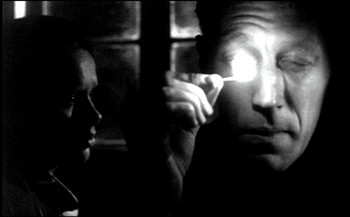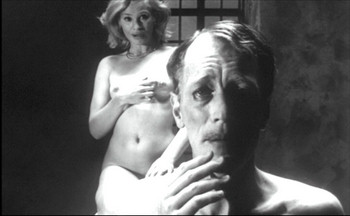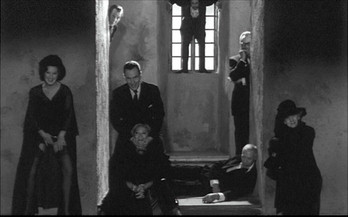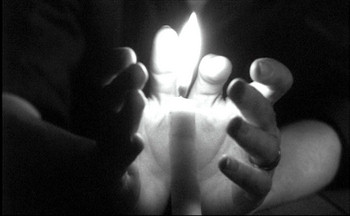Hour of the Wolf
 The deaths last week of movie writers and directors Ingmar Bergman and Michelangelo Antonioni have incited all sorts of commentary about the “art” films of yesteryear and the people who made them.
The deaths last week of movie writers and directors Ingmar Bergman and Michelangelo Antonioni have incited all sorts of commentary about the “art” films of yesteryear and the people who made them.
Tied up in these discussions is one key assumption: that everyday people think these movies are boring, whether they’ve actually seen them or not. “Boring” is a reaction separate from claiming something is “good” or “bad,” of course, but it’s almost more important. If something bores a viewer, it becomes irredeemably irrelevant. So people arguing for the importance of Bergman and Antonioni must first make their movies sexy.
 So: Ingmar Bergman’s Hour of the Wolf features nudity (female pubic hair, even!), murder, insanity, a woman who removes her face and plops her eye in a drink, a man who walks on the walls and ceiling in a fit of supernatural jealousy, a seemingly ordinary man who enters a building through a locked door … .
So: Ingmar Bergman’s Hour of the Wolf features nudity (female pubic hair, even!), murder, insanity, a woman who removes her face and plops her eye in a drink, a man who walks on the walls and ceiling in a fit of supernatural jealousy, a seemingly ordinary man who enters a building through a locked door … .
But, yes, if the recently inescapable stills of Death personified from The Seventh Seal immediately make you drowsy, you’ll find Hour of the Wolf unbearably slow, as well. Some people like black-and-white, subtitled existential movies; some people like I Now Pronounce You Chuck and Larry. You can convince (some) people of the value of Bergman, but you can’t make them like him.
In Hour of the Wolf, Max von Sydow plays an artist who’s going crazy, and he’s taking his pregnant wife (Liv Ullmann) with him. You’ve seen this movie before, with fantasy and reality bleeding together, conflict in the marriage, and a madness that finally overtakes the protagonist.
What distinguishes Bergman’s movie, first and foremost, is that its surreality never comes at the expense of its psychological accuracy. The horrors in Hour of the Wolf feel authentic, drawn from long experience with nightmares rather than movies. (Both this and Persona have their roots in a Bergman nervous breakdown.) There’s a boy, for instance, who stands behind the artist as he fishes, threatening because he is still and too close, threatening even though we can’t see his face.
Part of the power is that Bergman doesn’t draw undue attention to such things. They are presented matter-of-factly, with an understanding that they don’t need to be accentuated by music or the camera.
 And while the movie has its share of grotesqueries, the most unsettling thing about it is the accumulation of small, gnawing details – a facial expression, a conversational non sequitur, an old lady’s command to marvel at the skin on her feet, the intimate knowledge that the residents of a nearby castle seem to have about the artist’s life.
And while the movie has its share of grotesqueries, the most unsettling thing about it is the accumulation of small, gnawing details – a facial expression, a conversational non sequitur, an old lady’s command to marvel at the skin on her feet, the intimate knowledge that the residents of a nearby castle seem to have about the artist’s life.
One can certainly see in Hour of the Wolf a texture that we now call Lynch-ian, but there’s something much more clear-headed in Bergman’s movie. At the center of the movie is a quiet, articulate section that understands the fear of dreams instead of merely tapping into it. (The accompanying commentary track, part of Culture Snob’s Five Minutes series, can be listened to in the player above or downloaded.)
The artist and the wife are awake in the dead of night. He relates a memory of being locked in a closet as a child, kicking and screaming, deathly afraid of the little creature who lives there and nibbles the toes of naughty boys. When he’s let out of the closet, he faces his inevitable whipping with calm resignation. The artist is lighting matches, one after the other.
 His wife holds her hands around a candle in the next shot, more stable and steady. She, too, is afraid, but her concern is practical, rational, and forward-looking: their child. Yet this is also mundane, and Bergman dispenses with it in roughly a minute, compared to the four-plus minutes he gave to von Sydow’s speech.
His wife holds her hands around a candle in the next shot, more stable and steady. She, too, is afraid, but her concern is practical, rational, and forward-looking: their child. Yet this is also mundane, and Bergman dispenses with it in roughly a minute, compared to the four-plus minutes he gave to von Sydow’s speech.
It makes sense that the painter’s torment is given greater weight. The wife is a simple woman with “whole thoughts.” Her worries are easy to grasp.
The artist, though, is complicated and fractured, and therefore more compelling. He can handle worldly punishments – for what he did to that little boy, for example – with quiet strength. But those castle people, forever nibbling at his toes, are driving him fucking nuts.


I found Hour of the Wolf problematic, but it did hold my interest more than some of Bergman’s other films such as Cries and Whispers which I’ve seen twice and found myself bored both times.
Problematic how?
For me, the biggest problem with the movie is that it mines (now) overly familiar territory in a way that’s (now) overly familiar.
But for what it is, I find it bracing, beautifully constructed, and haunting.
I thought it had very interesting elements, but I watched it in the midst of a Bergman burst a year or so ago and it seemed to really pale next to others I watched at the time from around the same period such as Shame and even The Passion of Anna.
Fair enough. Those are two among many Bergman movies that I haven’t seen.
Definitely seek out Shame. It’s one of his best.
Is the scene with Vogler naked behind Von Sydow cut from the MGM dvd? I don’t recall that. It shows him humiliated and then the demons laugh at him, as I recall.
The images with this essay were captured from an MGM DVD (albeit one with an incorrect aspect ratio), so: No.